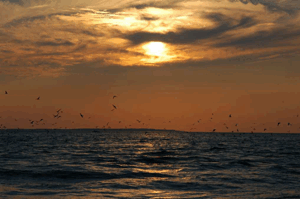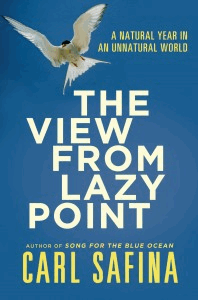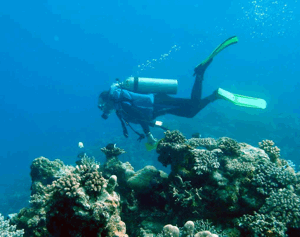The View from Lazy Point
Air Date: Week of January 14, 2011

The view from the beach near Carl Safina’s house at Lazy Point on Long Island. (Photo: Carl Safina)
In the course of a year, Carl Safina went around the world and back again. During his travels he realizes that environmental problems are inherently entwined with humanity’s past and future, and nature’s cycles of renewal. Safina is a marine science professor at Stony Brook University and heads the Blue Ocean Institute. He talks with Living on Earth’s Steve Curwood about his new book “The View From Lazy Point, A Natural Year in an Unnatural World.”
Transcript
GELLERMAN: Carl Safina is president of the Blue Ocean Institute and a marine science professor at Stony Brook University. For most of his adult life Safina’s traveled the seven seas researching and writing. But his most recent book takes place largely in his back yard on Long Island – it’s called, “The View From Lazy Point: A Natural Year in an Unnatural Word.”
SAFINA: Well you know the east end of Long Island kind of just sticks out into the ocean, and so there are fish that come up along the coast, and they all have to round that end and Lazy Point is right near the end so that’s why it’s a great place to be stationed to see these things.
GELLERMAN: There’s an underlying theme in Carl Safina’s book, “The View from Lazy Point.” He told Living on Earth’s Steve Curwood it’s a message of hope:

(Hentry Holt and Company)
SAFINA: Despite all the gloom and doom that we hear about the environment, I wanted to show that the world is still brimming with living vitality and there’s a lot left to save and a lot that really is worth working on.
CURWOOD: Tell me about the terns and the monarch butterflies you see at Lazy Point.
SAFINA: Terns are very long distance migrants. They go down to South America and they live an astonishingly long time. A tern that I banded in the early 80’s was recovered breeding on a nest just ten miles from Lazy Point on an island there, that tern was 27 years old, and it really floored me. And to live that long and travel that many thousands of miles and raise so many broods of young ones is a very, very impressive feat for any living thing.
And you also asked about the migrating monarch butterflies - they have a very bizarre migration. It takes them four generation to make the whole migration. I don’t know anything else like that. But, one generation starts in Mexico - they hatch, they come north, they breed in the southern United States, they hatch, go farther north, they breed around where we are, the ones that hatch where we are go into Canada, and the ones that hatch in Canada make a migration down to Mexico. It’s absolutely staggering.

The view from the beach near Carl Safina’s house at Lazy Point on Long Island. (Photo: Carl Safina)
CURWOOD: Tell me about your travels to Antarctica. You spent some time with the penguin scientists Wayne and Sue Trivelpiece, what was that like?
SAFINA: Antarctica, I think, is the most different place in the world. The ice and snow make everything seem so clean and pristine. The birds are fantastic - these big colonies of penguins - they’re stinky; they’re noisy. I was with them while they were studying the penguin’s relationship to their main food supply, which is a little shrimp - like thing called krill. And, what they were finding is that as the Southern Ocean warms up and the ice shrinks, there are fewer krill because when the krill are young they make a living by grazing algae from the underside of sea ice.
So, if the sea ice shrinks ten percent, that’s ten percent less food for the krill. And, what they were learning was that the penguins, they were getting fewer krill and that their young ones were not surviving as well. And, all of this is part of the effect of the warming of the Polar Regions. The Polar Regions are warming a lot faster than the temperate regions. And, everyone who lives or works in the Arctic or the Antarctic really feels climate changing on a year-to-year basis.
CURWOOD: In the course of your book you talk about a number of environmental problems, but you also focus on the positive. There’s a particular moment as you’re traveling, you wind up in the South Pacific, the islands of Palau there, and I’m thinking of your discussion of the parrotfish and the corals. Can you talk to us a little bit about that relationship?

Carl Safina SCUBA diving in Palau (Photo: Carl Safina)
SAFINA: Yeah. One of the problems around the world is that coral reefs are dying. And they’re dying because of a few different things- they’re dying because it’s getting to hot for them, they’re dying because the ocean pH is getting too acidic for them - and those two things are happening because of the fossil fuels we burn and the carbon dioxide that results. They’re also dying because they’re over-fished. For quite a few millions of years, what we think of as coral reefs in the modern sense, have been possible because of a family of fish called parrotfish.
And their teeth are fused together into these scrapers. And, what they do for a living mainly, is they scrape algae that is constantly trying to grow on the corals, and, that allows the corals to grow. Palau has had a very good policy of keeping the limits on fishing within the right parameters so that the reefs still have a lot of fish. They did that mainly because they’re really famous as a tourist destination for scuba diving. But, what they got in addition to the tourists was they kept their coral reefs.
CURWOOD: Carl Safina, at one point you go out mako shark fishing by yourself. I’m wondering if you could pick up your story about what happened that day. Page 223.
SAFINA: Okay. I had the weight of the fish in the leader on one hand and the weight of the long wooden harpoon shaft overhead. A man with a spear face to face with a large dangerous animal - an old, old scene. But, when the shark presented the perfect shot, I hesitated. The shark waited. I looked deep into that black eye, undefiant, matter-of-factly, the mako informed me that at this was no game. Not a sport. That eye rolled forward just a bit, and then back to me and then inquired - what next?

Carl Safina no longer fishes for Mako sharks like this one. (Photo: Carl Safina)
I reconsidered. Then I thrust. The mako blurred into lashing froth and blood. I reached for the gaff and sank it and swept him toward me and clinched the tail rope. Now, I had my prize. Now I’d have my steaks - grills would sizzle. At the dock came the expected congratulations. The admiring onlookers, male and female, the incredulous headshakes that I had conquered this fish alone. My name found its way into the weekly fishing columns, I had distinguished myself. Perhaps people would say, ‘he’s a good fisherman.’ But with sharks declining, I could not duck the fact that I was still drawing blood from such magnificent creatures. And that made the sought-after admiration feel hollow.
CURWOOD: So, Carl Safina, your entire life you’re a fisherman, and yet it sounds like now you have stopped fishing mako.
SAFINA: That was the last one I ever killed. That’s true. And, the bluefin tuna that used to be the greatest thrill I ever had fishing, I don’t fish for them anymore either, because it’s just not fun anymore. There are very few of them - usually don’t catch anything - but when you do, it’s just sad. I still do a lot of fishing, I fish for the fish that have come back as a result of really good management, or are still abundant but I think you have to make your choices and you have to pick and choose what is quality and what isn’t.
CURWOOD: And, what does that tell us about humanity’s relationship with nature?
SAFINA: Well, I think that we still have a very ancient relationship with nature in our minds, but the world has really changed. You know, if you look at all of the big institutional frameworks by which we conduct civilization, and I mean like the economy that we have, and the religions that provide us with our values - a common thread among them is that all of them were fully developed before anyone knew that the world was round. Way before it ever occurred to anyone that people could change the world.
That is a new realization, but our institutions don’t incorporate it. That is why, for instance, the economy can say that coal is really cheap, even though the costs of coal involve putting mercury in all of our seafood, destabilizing the heat balance of the whole planet, turning the oceans more acidic and dissolving shellfish and dissolving corals. We understand only the price of things, not the costs and not the true values.
CURWOOD: Now in your book you go so far as to compare our current economic dependence on fossil fuels: oil and coal, to our economic dependence on slavery. Can you explain that to me?
SAFINA: Well, we crossed a bridge before in this country, and in fact in Western civilization, where people were saying, you know, you can’t change our energy base, or the economy will fall apart because we need cheap energy. But, the cheapest energy we’ve ever had was slaves. We were told that the economy would not survive a switch away from slaves, and we’re told now that the economy will not survive a switch away form fossil fuels. We’re using a very, very expensive and really not moral form of energy and we’re telling each other that it’s what we have to use because it’s cheap. And that’s the same argument that people who had slaves used.
CURWOOD: So, things are bad but we still have a chance to turn them right - is what you’re saying, Carl Safina.
SAFINA: Where there’s life, they’re hope. That’s a truism - and it is true. There’s a lot left. The main conclusion I came to at the end of this year of observation and of travel is that nature and human dignity require each other. Our community is not just the people around us, it’s us, it’s the living world, and it’s the generations that will come after us. We are just the current iteration in a long chain of being. We owe everything about us to the people before us. And, we have a responsibility to the people who will come after us as well.
CURWOOD: Carl Safina’s new book is called, “The View from Lazy Point: A Natural Year in an Unnatural World.” Thanks very much, Carl.
SAFINA: Thank you, very much. I really appreciate it.
GELLERMAN: Marine scientist Carl Safina spoke with Living on Earth’s Steve Curwood.
Links
Living on Earth wants to hear from you!
Living on Earth
62 Calef Highway, Suite 212
Lee, NH 03861
Telephone: 617-287-4121
E-mail: comments@loe.org
Newsletter [Click here]
Donate to Living on Earth!
Living on Earth is an independent media program and relies entirely on contributions from listeners and institutions supporting public service. Please donate now to preserve an independent environmental voice.
NewsletterLiving on Earth offers a weekly delivery of the show's rundown to your mailbox. Sign up for our newsletter today!
 Sailors For The Sea: Be the change you want to sea.
Sailors For The Sea: Be the change you want to sea.
 The Grantham Foundation for the Protection of the Environment: Committed to protecting and improving the health of the global environment.
The Grantham Foundation for the Protection of the Environment: Committed to protecting and improving the health of the global environment.
 Contribute to Living on Earth and receive, as our gift to you, an archival print of one of Mark Seth Lender's extraordinary wildlife photographs. Follow the link to see Mark's current collection of photographs.
Contribute to Living on Earth and receive, as our gift to you, an archival print of one of Mark Seth Lender's extraordinary wildlife photographs. Follow the link to see Mark's current collection of photographs.
 Buy a signed copy of Mark Seth Lender's book Smeagull the Seagull & support Living on Earth
Buy a signed copy of Mark Seth Lender's book Smeagull the Seagull & support Living on Earth

